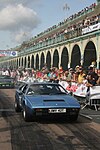Bristol Road Methodist Church
1989 disestablishments in England19th-century Methodist church buildings19th-century churches in the United KingdomChurches completed in 1873Churches in Brighton and Hove ... and 7 more
Former Methodist churches in the United KingdomFormer churches in Brighton and HoveGrade II listed buildings in Brighton and HoveGrade II listed churches in East SussexMethodist churches in East SussexRecording studios in EnglandRomanesque Revival church buildings in England

Bristol Road Methodist Church is a former Methodist place of worship in the Kemptown area of Brighton, part of the English city of Brighton and Hove. Built in 1873 to an Italian Romanesque Revival design, it served this part of eastern Brighton for more than a century until its closure in 1989, after which it became a recording studio. It is owned by Brighton College, an independent school based nearby. The building has been listed at Grade II in view of its architectural importance.
Excerpt from the Wikipedia article Bristol Road Methodist Church (License: CC BY-SA 3.0, Authors, Images).Bristol Road Methodist Church
Montague Place, Brighton Kemptown
Geographical coordinates (GPS) Address Nearby Places Show on map
Geographical coordinates (GPS)
| Latitude | Longitude |
|---|---|
| N 50.8196 ° | E -0.1245 ° |
Address
Brighton College Drama & Music
Montague Place
BN2 1JE Brighton, Kemptown
England, United Kingdom
Open on Google Maps








